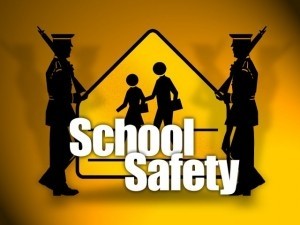School Safety Procedures

Children should feel and be safe at school. School violence, though, threatens a child's well-being and makes school a scary place for threatened or victimized children. The National Center for Education Statistics claims that 85 percent of public schools reported violence, theft or other crimes for the 2007 to 2008 school year. Though the statistics can be disheartening, administrators and teachers can take basic steps to help keep students safe.
Sign-In Procedures
While most school visitors are in the building to help or visit students, schools can have procedures in place to keep track of all visitors. When visitors enter the building, require them to sign-in at the front office. They should sign a log and present photo identification to office staff. Photo identification ensures that the proper authorities can be notified of everyone's identity should an emergency occur. Give visitors a visitor badge that they can wear around their neck or possibly a sticker to display on their shirt. That way, building employees and students will know the person is a visitor, and if they see an unfamiliar face without a visitor badge, they can alert school administrators.
Missing Children
Many schools use computers to take attendance. Schools, particularly high schools, can detect missing or skipping children immediately if the school requires its teachers to take attendance within the first 10 minutes of class. That way, if a student was present in the previous class period, administrators will be able to know if he's skipping class or possibly missing almost immediately.
Student Identification
Schools, particularly large schools, should have some kind of identification system for all students and staff. This could simply be an identification badge that students and staff wear around their necks with their picture, name and grade level. If student identification badges are new to the district or school, the students might fight the badges and refuse to wear them or keep forgetting them. Imposing strict penalties for not wearing the badge, such as a detention or a day of in-school suspension after a certain number of offenses, can ensure that students will wear the proper identification. In addition, administrators can offer the first badge for free, but then charge for lost badges.
School Safety Week
According to the National School Safety Center, a national school safety week--usually in October--gives administrators a chance to review safety procedures with students and staff. The National School Safety Center also recommends that administrators keep up to date on the current safety issues and data and share this information with their district and staff during this week. This information can be used to create district-specific policies. This week is also a good time to incorporate safety-related issues into the school's curriculum to keep students aware of potential problems and their solutions.
Sign-In Procedures
While most school visitors are in the building to help or visit students, schools can have procedures in place to keep track of all visitors. When visitors enter the building, require them to sign-in at the front office. They should sign a log and present photo identification to office staff. Photo identification ensures that the proper authorities can be notified of everyone's identity should an emergency occur. Give visitors a visitor badge that they can wear around their neck or possibly a sticker to display on their shirt. That way, building employees and students will know the person is a visitor, and if they see an unfamiliar face without a visitor badge, they can alert school administrators.
Missing Children
Many schools use computers to take attendance. Schools, particularly high schools, can detect missing or skipping children immediately if the school requires its teachers to take attendance within the first 10 minutes of class. That way, if a student was present in the previous class period, administrators will be able to know if he's skipping class or possibly missing almost immediately.
Student Identification
Schools, particularly large schools, should have some kind of identification system for all students and staff. This could simply be an identification badge that students and staff wear around their necks with their picture, name and grade level. If student identification badges are new to the district or school, the students might fight the badges and refuse to wear them or keep forgetting them. Imposing strict penalties for not wearing the badge, such as a detention or a day of in-school suspension after a certain number of offenses, can ensure that students will wear the proper identification. In addition, administrators can offer the first badge for free, but then charge for lost badges.
School Safety Week
According to the National School Safety Center, a national school safety week--usually in October--gives administrators a chance to review safety procedures with students and staff. The National School Safety Center also recommends that administrators keep up to date on the current safety issues and data and share this information with their district and staff during this week. This information can be used to create district-specific policies. This week is also a good time to incorporate safety-related issues into the school's curriculum to keep students aware of potential problems and their solutions.
- 0de0bf42b72768e99a143aa12b9ae85c1f.jpg